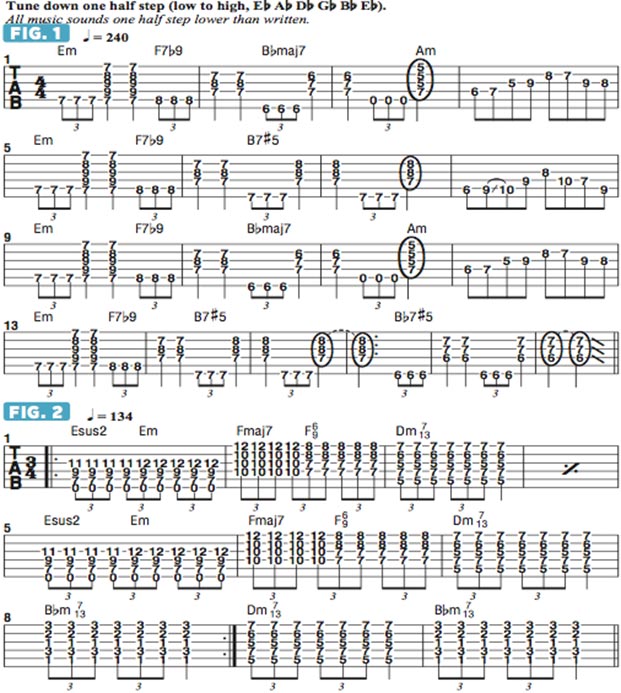Incorporating Jazz Chords Into Metal
Try introducing some jazz-type chord voicings and harmonies into your metal riffs.
Hello everyone, and welcome to my latest round of Guitar World columns! It’s great to be back, and I sincerely hope these lessons will be illuminating and useful to you in your own personal musical endeavors.
Though my chosen genre of music with my band Revocation is metal, I studied jazz guitar at Berklee College of Music, and I am always looking for creative ways to expand the musical palette of metal via the use of jazz-type chord voicings and harmonies. It’s great to introduce different sounds to metal that are not normally associated with the genre.
For all of the examples illustrated here, my seven-string guitar is tuned down one half step (low to high: Bb Eb Ab Db Gb Bb Eb). In order to make the lessons accessible to six-string players, however, I’ll avoid using the seventh string, so all of the examples presented can be performed on six-string instruments.
FIGURE 1 comes from the Revocation song “Communion,” featured on our latest release, Great Is Our Sin (Metal Blade). The lick is played in 4/4 time at a very fast tempo of 240 beats per minute. Before delving into the jazz-like harmony of the chords, I should point out that the passage is rhythmically contoured with a lot of three-beat groups played back to back. So, feel-wise, each four-bar phrase may alternatively be counted as four bars of 3/4 followed by a bar of 4/4; But one can simply count straight 4/4 through the entire example, as notated here, which I prefer because it accentuates this rhythmic ambiguity.
Before strumming each new chord, I alternate-pick its root note in a fast eighth-note triplet rhythm. I begin with a basic Em chord, followed by the jagged sounding F7b9 and Bbmaj7 chords. Bar 3 ends with Am, after which I play a single-note line in straight eighth notes that is based on the fifth mode of E harmonic minor (E F# G A B C D#) with a G# passing tone included.
This lick serves as a nod to the altered-dominant five chord of Em, B7#5, which then resolves back to the Em, the one chord. In bar 6, B7#5 replaces the Bbmaj7 and Am chords that were played the first time through the pattern. The same fifth mode of E harmonic minor is used for the single-note passage in bar 8, but here I focus on the diminished seventh tones—D#, F#, A and C—which allude to both B7+#5 and Cdim7. The entire eight-bar phrase then repeats, beginning in bar 9, and in bar 16 I simply drop down one half step from B7#5 to Bb7#5.
FIGURE 2 is from a song called “Profanum Vulgus,” also from Great Is Our Sin. This riff is played in 3/4 meter and at a much slower tempo of 134 beats per minute. The entire figure is built from shifting chord voicings, starting with an Esus2 “spread” voicing of “stacked fifths” that spans four frets then expands to Em and a five-fret span, followed by an Fmaj7 chord in second inversion (with the fifth in the bass) and a first-inversion (third in the bass) F6/9 chord. The three-bar pattern ends with a dense, complex-sounding Dm7/13 chord. As you can see, these are not the “normal” type of chords one usually hears in metal-based music. Bars 1–3 are repeated in bars 5–7, after which the Dm7/13 voicing moves down two whole steps to Bbm7/13.
Now that you have an idea of the approach used in these songs, try devising your own unusual “jazzy” chord progressions within the framework of metal music. Don’t be afraid to experiment. If it sounds good, it is good!

Get The Pick Newsletter
All the latest guitar news, interviews, lessons, reviews, deals and more, direct to your inbox!








![Joe Bonamassa [left] wears a deep blue suit and polka-dotted shirt and plays his green refin Strat; the late Irish blues legend Rory Gallagher [right] screams and inflicts some punishment on his heavily worn number one Stratocaster.](https://cdn.mos.cms.futurecdn.net/cw28h7UBcTVfTLs7p7eiLe.jpg)

